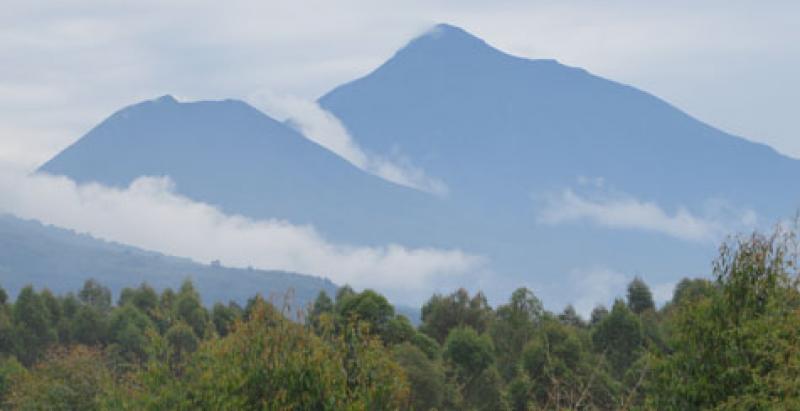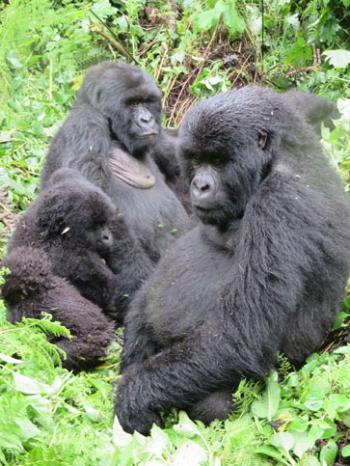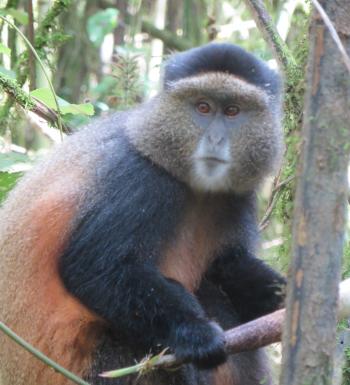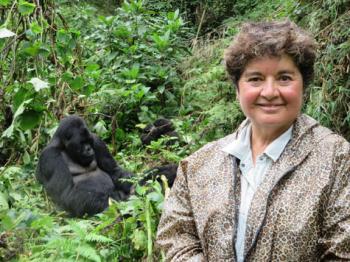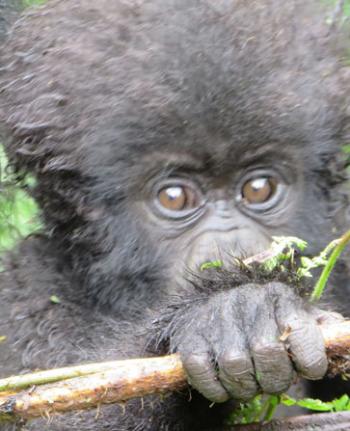Mountain gorillas in Rwanda
This item appears on page 27 of the April 2017 issue.
Whenever I want to treat myself to a trip on which I know I will have an excellent guide, top-quality hotels and an exciting and unusual itinerary along with well-traveled and interesting fellow travelers, I book with Passport Travel & Tours, a family-owned company located near Chicago (Grayslake, IL; 847/543-6729, http://journeyswithbillball.wix.com/passporttraveltours).
I have done seven trips with them over the years and consider Bill Ball, the owner and guide for all of their trips, to be one of the most professional, accountable and client-centered people I’ve ever met. He also does travel documentaries for PBS; his 13-part “Journeys in India” won an Emmy.
Bill announces his trips a year and a half in advance, allowing prospective participants an “early-bird discount.” When I learned about his 2015 “Gorillas in the Mist” trip to Rwanda, with a group limit of 12, I signed up right away. We ended up with nine participants.
The cost of the trip, Oct. 1-13, was $8,595, including air from Chicago. However, I handled my own air using frequent-flyer miles, so I received an air credit of $1,600. I also paid a single supplement of $960, making my total trip cost $7,955.
The price included transportation, baggage handling, all meals, all gratuities and the all-important gorilla trekking permit ($750), a permit to see the rare golden monkeys ($100) and all national park and museum entrance fees.
Though the brochure stated “First Class Hotel Accommodations” throughout, we were in three 5-star properties and in the best available near the remote Volcanoes National Park.
I paid extra only for drinks at meals, spa services at Nyungwe Forest Lodge and Kigali Serena Hotel and souvenirs.
The trip began in Kigali, Rwanda, at Hôtel des Mille Collines by Kempinski* (aka Hotel Rwanda, where Paul Rusesabagina, a hotel manager, housed over a thousand Tutsi and Hutu refugees during their civil war and genocide in spring 1994). We visited several memorials in the area, including the excellent Kigali Genocide Memorial Centre.
We then traveled to Akagera National Park, where we stayed at Ruzizi Tented Lodge. Each tent was accessed from raised boardwalks and had its own waterfront view. The way the 10 tents were situated, we couldn’t see or feel the presence of any other tents.
There we had a full-day safari, as the park had elephants, lions, zebras, giraffes, leopards, hyenas, hippos and 525 species of birds. We also enjoyed a boat cruise, cut short by a rainstorm.
In Nyungwe, we stayed at the exquisite Nyungwe Forest Lodge, in the middle of a tea plantation, and had a chimp and monkey safari as well as a canopy and forest walk.
•
The highlight of the trip was our visit to Volcanoes National Park, home to mountain gorillas. We stayed at Mountain Gorilla View Lodge, where our individual large, stone-and-thatch bungalows were comfortable and charming.
On the day of our trek, we reported to the park headquarters at 7 a.m. Our guide submitted our permits and passports and requested the “easy trek” (where gorillas are within a one-hour walk) for seven of us and the more difficult walk (with gorillas two-plus hours away and the trek on steeper terrain) for the other five participants.
We each were assigned a porter to carry our backpacks ($10 per person, paid by Passport Travel), then we set off. The porters not only carried our stuff but helped us over the rough spots, including a wide ravine, where six porters set up an assembly line to pass us down a steep bank and up the other side.
Though we were able to be with the gorillas only for an hour, it was a “pinch me, I’m really here” experience. Our family of gorillas was part of the Kwitonda group, which has 23 members. We were able to observe 12 while they ate, tussled with each other, preened each other and sunbathed.
Gorillas are difficult to track, and they move around a lot. Our “easy” trek ended up being a steeper, “moderate” trek. One person with a pedometer said we trekked a total of 7.5 miles that day.
When we were about five minutes away from the animals, we were asked to leave our backpacks, walking sticks and water with the porters and take only our cameras.
Though park rules state that we had to stay 18 feet away from the gorillas at all times, because of the way our troop was situated and the surrounding foliage, we were always within 6 to 8 feet of the gorillas. I took 600 photographs that day!
It was a privilege to look into the eyes of these animals, knowing that we share 97.7% of the same DNA. (I’ve heard that people shouldn’t make eye contact with gorillas, since it can be perceived as hostile, but I couldn’t avoid looking at them when they stared at me. It was the silverback that could be aggressive when looked in the eye.)
The hour we were allowed to be with the gorillas went way too fast. Too soon, we had to trek back to the trailhead where our vehicles waited.
Things to remember if you’re doing a gorilla trek in
Rwanda —
• If you show signs of a cold or any other contagious ailment, you won’t be allowed to trek that day, as gorillas have no immunity to our diseases. Keep yourself healthy.
• Even if it’s a hot day, you must wear long pants and long-sleeved tops, as there are biting ants, stinging nettles and bushes with thorns everywhere.
• Wear hiking boots. I had low-tops and wished I had taken a pair with ankle support.
• If you have a walking stick, take it. Otherwise, you can borrow one from the porters.
• Chances are 99.99% that you’ll have a steep climb to see the animals, causing you to sweat. Also, keep in mind that, even for the easy and moderate treks, you’re at 6,000 to 8,000 feet. Take plenty of water, and think about adding a bit of rehydration salts to your bottles to replace the electrolytes you lose.
• Book a massage at the hotel for the afternoon you return from trekking. The masseuse knows to work on your calves, thighs, back and feet. Your body will thank you!
Things to remember in general for Rwanda —
• If you plan to visit neighboring Kenya or Uganda, consider the T12 East Africa Tourist Visa, which allows multiple entries into these countries and is valid for three months. (I visited Kenya for 10 days just prior to visiting Rwanda, so I had one of these visas.)
• Take your yellow fever vaccination card. It’s a requirement for entering Rwanda, even though, in our group, no one was asked to show it.
• Rwanda is a cash-only economy. And the ATMs provide cash advances only from Visa and MasterCard. So take plenty of clean, unmarked, recent-date US dollars with you. Small denominations are helpful for buying souvenirs.
• Credit cards were able to be used for extra services in the hotels we stayed in.
• Plastic bags (the thin kind from the grocery store) are banned in Rwanda. Having your own bag is helpful when shopping. Merchants will give you a paper bag.
This trip with Passport Travel was a wonderful experience. I rarely have occasion to say this, but I would do this trip again.
ESTHER PERICA
*As of April 2016, Hôtel des Mille Collines is no longer owned by Kempinski.

